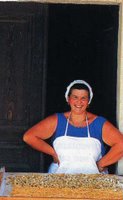Changing Times in the Piemonte
 The Slow Food movement has been heartily embraced by the Piemonte region. I am sure that has something to do with the fact that Slow Food is based in Bra and is the brainchild of a Piemontese. Being a new pilgrim to the Piemonte it is difficult for me to say exactly how much change has occurred over the last 20 years but evidence is everywhere. That little snail pops-up in the darnedest places! But it is not just about a concept it’s about a mindset. As I speak to the winemakers and the butchers and the ladies at the Pasticceria I begin to realize that they are not just doing this for extra profit, they are just so proud of their craft and want to share it with us. As you know, Italy is not the richest country in Europe and the exotic material possessions we find everywhere in the US are often simply not available, even if the money was available to purchase them. Consequently, less emphasis is placed on material possessions and more value is ascribed to things like food and wine. In Italy if you want respect all you have to do is provide a perfect bon-bon or the finest cuts of meat, or maybe a bottle of perfect Barolo. This will ensure your place in the community and keep you continually surrounded with admiring customers. Great butchers walk a few inches off the ground in the Piemonte and rightly so too!
The Slow Food movement has been heartily embraced by the Piemonte region. I am sure that has something to do with the fact that Slow Food is based in Bra and is the brainchild of a Piemontese. Being a new pilgrim to the Piemonte it is difficult for me to say exactly how much change has occurred over the last 20 years but evidence is everywhere. That little snail pops-up in the darnedest places! But it is not just about a concept it’s about a mindset. As I speak to the winemakers and the butchers and the ladies at the Pasticceria I begin to realize that they are not just doing this for extra profit, they are just so proud of their craft and want to share it with us. As you know, Italy is not the richest country in Europe and the exotic material possessions we find everywhere in the US are often simply not available, even if the money was available to purchase them. Consequently, less emphasis is placed on material possessions and more value is ascribed to things like food and wine. In Italy if you want respect all you have to do is provide a perfect bon-bon or the finest cuts of meat, or maybe a bottle of perfect Barolo. This will ensure your place in the community and keep you continually surrounded with admiring customers. Great butchers walk a few inches off the ground in the Piemonte and rightly so too!As mentioned, I can really only take a “time-slice” of current events and I can’t speak with much authority about the way things “used to be” or exactly what has brought on the change, but I do know change is happening. For example; I have a favorite wine here and it is called Barbera. I have asked a few questions about its history and it seems that Barbera was once a wine that was mass-produced and cheap, consequently it was considered plonk and rightfully avoided by anyone with a palate. But gradually things changed and the Barbera growers began to trim back their vines and tend them more selectively and with some careful vinification the results can be staggering. We are seeing Barberas spending time in oak, and some is even blended with Nebbiolo and other grapes to make some tremendously complex cuvees. Today the best Barberas bring top-money and are worth every penny.
Grignolino has a similar story. In many cases it is often almost a rosé, but now a few producers are producing stellar Grignolino. We are even seeing alcohol levels in excess of 14% and they are starting to garner some international recognition, not to mention multiple-cups in Gambero Rosso. In spite of all that, Grignolino is not widely grown here. I believe the problem is that most people don’t understand the wine outside of the region. Grignolino is a wine that was made to be enjoyed with cured meats, especially the fattier salumi like coppa and salami. It cuts right through the fat and the flavor of the Grignolino blends perfectly with the sweet nuttiness of the meats. Once you have a Grignolino with a good local salami you will be hooked for good. Just a word of caution: don’t be tempted to judge this wine at a wine tasting… as with many Italian wines, it will not fare well without the food it was intended for.
But it is not only wine that is changing. In the Piemonte every village is known to produce something special. It might be a type of cake, or perhaps there is a butcher there that makes a special sausage, or it might even just be a certain dish that that town is famous for. There is a constant stream of new creations from the village shops. All of this creates a very completive spirit in the food and wine world and when you combine all of that with a public that is devoted to the table from the moment they learn to walk, some very magical things happen!
This is the glory of the Piemonte!







